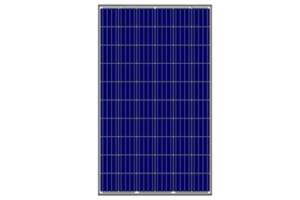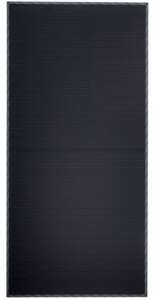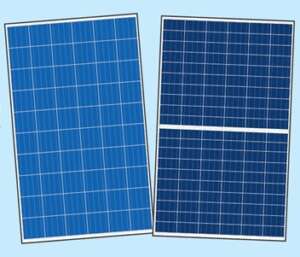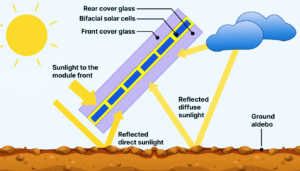If you are researching for a solar power system, solar panels are the most important component. They are the heart of the system and also make up to 70% of the total cost you will pay for the system. It is only natural that you should make an informed decision regarding the panels you would like to use when you go solar.
To start simple – let us look at the solar cells that make up the panels – and are the biggest factor to determine which type it is. Most of the solar panels in the market are of the following three categories:
- Monocrystalline solar panels,
- Polycrystalline solar panels, and
- Thin film solar panels.
Each type of solar cell has different characteristics, thus making certain panels better suited for different situations. This detailed guide will help you decide which type is right for you.
1. Monocrystalline solar panels (or Mono)

Monocrystalline solar panels, made of pure silicon cells, are considered to be the most efficient solar panels because of their 16% to 20% energy efficiency rate.
They have a good lifespan of over 25 years and require lesser roof space for accommodation.
2. Polycrystalline solar panels (or Poly)

Polycrystalline solar panels are made up of fragments of silicon crystals. They feature 13% to 15% efficiency. Although they provide less efficiency, they are more economical than monocrystalline solar panels.
While they were more popular in India earlier, people have now moved on to Mono solar panels because of better efficiency
3. Thin-film solar panels

Thin-film solar panels are lightweight but the least efficient compared to the other two types. These solar panels provide 7% to 10% efficiency.
Materials like copper indium gallium selenide, amorphous silicon, and cadmium telluride are used in their manufacturing. Unlike the other two, these solar panels can tolerate high heat. They are economical and feature a flexible structure.
Technologies to increase efficiency
Additionally – we would like to highlight three key technology components which have resulted in more efficient variants on the above panel types
PERC
Passivated Emitter and Rear Contact cells, or PERC cells, are becoming an increasingly popular monocrystalline option. PERC cells go through a different manufacturing and assembly process that increases the amount of electricity the cells can produce. It does so by capturing as many extra photons as possible without fundamentally changing how a solar cell works.
In ordinary crystalline silicon solar cells, electricity is produced when photons hit a layer of silicon, knocking electrons loose and then directed to flow along a wire. In general, modern monocrystalline silicon solar cells can convert about 19-20% of the incoming photons to electricity, but some photons pass through the silicon material without exciting electrons.
When these cells are built into a solar module, the unconverted photons can hit the aluminum back layer and turn into heat, which reduces cell efficiency. PERC solves these issues by helping utilizing some of the unutilized photons – thereby increasing efficiency
Half-cut panels
Half-cut solar cell technology increases the energy output of solar panels by reducing the size of the cells, so more can fit on the panel. The panel is then split in half so the top operates independently of the bottom. While traditional solar panels usually have 60 to 72 solar cells, half-cut panels have 120 to 144 cells. This results in more energy creation – even if one half is shaded.

You can find more details on How half-cut panels increase efficiency
Bi-facial panels
Bifacial solar panels offer what traditional panels cannot – the ability to absorb sunlight from the bottom of the panel, in addition to the top. Bifacial solar panels can capture the light that traditional panels miss, making your solar panels extra efficient
The panel is constructed such that the solar cells absorb light from both the front and the rear side of the panel. That means that instead of letting valuable light go to waste, the back of the panel can absorb it.

Installations need to ensure that the bottom part of the panel, the backsheet, needs to be exposed. Hence it may not be used in many installation types – such as rooftops, where typically there is less space below the panels. In fact these are mainly used in ground mounted installations.
Because they are still relatively new, bifacial panels are not produced by all solar panel manufacturers.
Comparing the panels
Let us compare in brief on the three broad solar panel types across key parameters such as efficiency, cost, appearance, etc. to help you decide which is the best solar panel for home or business
Solar panel type by performance or efficiency
In short: Monocrystalline > Polycrystalline > Thin film
Efficiency ratings of monocrystalline solar panels range from 17% to 22%, earning them the title of the most efficient solar panel type. The higher efficiency rating of monocrystalline panels makes them ideal for homes with limited roof space, as you’ll need fewer panels to generate the electricity you need. A single mono solar panel output ranges from 400W to 650W
Polycrystalline panel efficiency ratings will typically range from 15% to 17%. The lower efficiency of polycrystalline panels also means they tend to have a lower power output than monocrystalline panels. A single poly solar panel output ranges from 240W to 350W
Thin film panels have a very low efficiency of 7% to 10%. thin film solar panels don’t really make sense for residential installations where space is limited. Their utilization is mostly limited to areas where mono and poly panels cannot be used such as car/ bus rooftops, etc.
Solar panel type by cost
In short: Monocrystalline > Polycrystalline > Thin film
Monocrystalline panels are the most expensive of the three types of solar panels because of their manufacturing process and higher performance abilities.
Historically, polycrystalline panels have been the cheapest option for homeowners going solar, without majorly sacrificing panel performance. Low prices allowed polycrystalline panels to make up a significant market share in residential solar installations earlier. However, the price gap between monocrystalline and polycrystalline panels has narrowed significantly.
Thin film solar panels have the lowest cost of the solar panel types, largely because they are easier to install and require less equipment.
Solar panel type by appearance
In short: Thin film > Monocrystalline > Polycrystalline
Thin film panels have a clean, all-black look. Their thin design allows them to lie flat against roofs, so they can blend in more seamlessly.
Monocrystalline panels have a solid black appearance, making them pretty subtle on your roof.
What is the best type of solar panel for your home?
Monocrystalline solar panels are the best solar panel type for residential solar installations.
Although you will be paying a slightly higher price, you’ll get a system with a subtle appearance without having to sacrifice performance or durability. Plus, the high efficiency and power output ratings you get with monocrystalline panels can provide you with better savings over the lifetime of your system.
Most of the solar panels now used are Monocrystalline PERC Half Cut panels.
Top 5 Most Efficient Solar Panel Manufacturers in India
The following is a list of the most trusted brands that produce the most efficient solar panels.
- Tata Solar
Tata Solar company manufactures some of the best solar panels in India. All their solar PV modules, including monocrystalline, polycrystalline, and thin films, are highly efficient and durable.
They have been in the business for 20+ years and produced 2 GW+ modules. They come with increased shelf life. Their solar panels can provide great low-light performance and deliver optimised energy output.
- Adani Solar
One of the largest and most reliable solar panel manufacturers and are amongst the top 15 global solar manufacturers. They have a capacity of 4 GW
Adani solar panels have earned the reputation of being highly reliable and offer optimal performance.
- RenewSys Solar
Renewsys Solar is a leading integrated manufacturer of Solar PV Modules and their key components – Encapsulants, Backsheets, and Solar PV Cells. They have a capacity of 2 GW+ and is part of the Approved List of Models and Manufacturers (ALMM) by the Indian government.
The company supplies high-efficiency modules to over 40 countries.
- Vikram Solar
Vikram Solar is one of the leading solar manufacturing companies in India & the biggest solar projects installer in the south India region. They are known for their manufacturing capacity & the efficiency of their solar panels. They have a manufacturing capacity of 2.5 GW
Vikram solar panels are widely used in India and are considered amongst the most efficient solar panels today.
- Waaree Energies
Waaree is India’s renowned solar panel manufacturer & the biggest exporter in the USA. They are known for the quality of their products. They have a manufacturing capacity of 5GW+
Waaree Energies is one of the oldest EPC players in India. The company offers project development, solar rooftop solutions, power plant, and solar water pump solutions.



